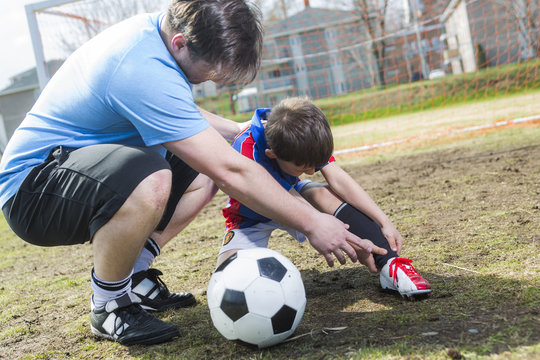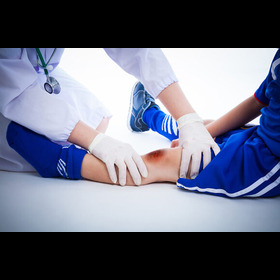
Types of Common Injuries
Sports injuries in children can range from minor cuts and bruises to more serious conditions that require medical attention. Some of the most common injuries include:- Sprains and Strains – Sprains involve stretched or torn ligaments, often affecting the ankles or wrists, while strains involve muscles or tendons. They typically occur due to sudden twists or overuse.
- Fractures – Broken bones are common in high-impact sports or from falls. Children’s bones are still developing, so prompt medical assessment is important.
- Dislocations – Occur when bones are forced out of their joint, often in the shoulder or fingers. Immediate medical attention is necessary to prevent long-term damage.
- Concussions – Head injuries resulting from falls, collisions, or contact sports. Even mild concussions require careful monitoring for symptoms such as dizziness, headaches, or confusion.
- Overuse Injuries – These develop gradually due to repetitive movements, common in sports like tennis, swimming, or running. Examples include stress fractures, tendinitis, and Osgood-Schlatter disease.
Preventive Measures and Warm-Ups
Prevention is always better than cure. There are a number of measures parents and coaches can take to minimize the risk of sports injury: Proper Warm-Ups and Stretching – Have children warm up prior to sport for at least 10–15 minutes. Dynamic stretching, jogging lightly, and sport-specific drill warm muscles and joints for action. Protective Equipment – Helmets, shin guards, knee pads, wrist guards, and proper footwear can lower the risk of injury substantially. Training in Technique – Proper training in running, jumping, tackling, or lifting techniques can avoid acute and overuse injuries. Activity at the Right Age – Have children engage in sport appropriate for their age and stage of development. Overloading young athletes with intense training may raise the risk of injury. Hydration and Nutrition – Adequate hydration prior to, during, and after sports and a healthy diet high in protein, calcium, and vitamins aids in muscle recovery and bone health. By incorporating these preventive steps, children can play sports safely and reduce the risk of injury.Basic First Aid and When to Consult a Pediatrician
Even with prevention, accidents can still happen. Understanding basic first aid can make a big difference in outcomes: RICE Technique – For strain and sprain, adhere to Rest, Ice, Compression, and Elevation. Rest the affected area, use ice for 15–20 minutes every few hours, wear a compression bandage, and elevate the extremity to prevent swelling. Bleeding and Cuts – Wash minor cuts with soap and water, use antiseptic, and dress with a sterile bandage. Get medical help if bleeding doesn’t stop or if the cut is deep. Concussions – Watch out for dizziness, vomiting, confusion, or headache. Do not return to athletics until cleared by a pediatric orthopedic specialist. Fractures and Dislocations – Splint the area, do not move the injured extremity, and get immediate medical help. Recognizing when to take help of professional services is vital. The persistent pain, swelling, deformity, inability to weight-bear, or neurological symptoms always necessitate a physician’s evaluation.Rehabilitation and Recovery Plans
Recovery from a sports injury is as important as prevention. A well-structured rehabilitation plan promotes healing and prevents re-injury: Medical Supervision – Follow the treatment plan prescribed by a pediatrician, a pediatric orthopedic specialist, or physiotherapist. Children’s recovery times may vary depending on the injury and age. Physiotherapy – Strengthening exercises, range-of-motion drills, and balance training help restore function and prevent stiffness. Gradual Return to Activity – Avoid rushing back into full sports participation. Start with low-intensity exercises and progressively increase activity under supervision. Monitoring for Complications – Watch for signs of infection, delayed healing, or recurring pain. Early intervention improves long-term outcomes. Supportive Equipment – Use braces, wraps, or orthotics as recommended to protect the injured area during rehabilitation. A comprehensive recovery plan not only addresses physical healing but also builds confidence in children to return safely to sports.Psychological Impact of Injuries
Sports injuries can be stressful for children, affecting both their emotional wellbeing and performance. Common psychological effects include: Fear of Re-Injury – Children may feel anxious or hesitant to fully participate after an injury. Frustration and Low Motivation – Being sidelined from sports can cause boredom, sadness, or a sense of exclusion from peers. Pressure from Parents or Coaches – Unrealistic expectations to return too soon can exacerbate stress and impact recovery. Supporting the child emotionally is just as important as physical rehabilitation. Encourage open communication, set realistic goals, and celebrate small milestones in recovery. Professional counseling or sports psychologists can also be beneficial in managing anxiety and rebuilding confidence.Safe Return to Sports
Returning to sports after an injury should be gradual and carefully monitored to prevent setbacks: Medical Clearance – Always consult a pediatrician, orthopedic specialist, or sports medicine expert before resuming competitive activity. Stepwise Progression – Start with light training, non-contact drills, or reduced intensity sessions. Gradually reintroduce full activity as tolerated. Ongoing Strengthening – Continue exercises to maintain flexibility, strength, and balance. This reduces the risk of future injuries. Education on Self-Monitoring – Teach children to recognize pain, fatigue, or unusual symptoms and to report them immediately. Adhering to these steps ensures a safe, effective return to sports while protecting long-term health and performance.Conclusion
Sports play a vital role in a child’s physical and social development, but they come with the risk of injury. By understanding the types of common injuries, implementing preventive measures, knowing basic first aid, and following structured rehabilitation and recovery plans, parents and coaches can significantly reduce risks and support children in safe participation. Equally important is addressing the psychological impact of injuries, encouraging confidence, and promoting positive approach to sports. Ankura Hospital’s expert pediatric team provides guidance and specialized care to ensure children recover safely and continue to enjoy sports. A child’s health should always be a priority. For guidance on prevention, first aid, or recovery plans tailored to your child’s needs, consult a pediatrician or a pediatric orthopedic specialist. With the right approach, children can enjoy the benefits of sports while minimizing injury risks and returning safely to their favorite activities.FAQ’s for Sports Injuries in Children: Prevention, Symptoms, Treatment, First Aid and Recovery Tips
The most frequent sports injuries in children include sprains, strains, fractures, dislocations, concussions, and overuse injuries such as tendinitis or stress fractures. Early recognition helps ensure proper treatment.
Prevention includes proper warm-ups and stretching, using protective equipment, learning correct techniques, participating in age-appropriate activities, and maintaining good hydration and nutrition.
RICE stands for Rest, Ice, Compression, and Elevation. It is a first aid technique used to reduce pain, swelling, and promote healing for minor sprains and strains.
Seek medical attention if there is persistent pain, swelling, deformity, inability to bear weight, or neurological symptoms. Fractures, dislocations, and concussions always require a doctor’s evaluation.
Recovery varies depending on the type and severity of injury, the child’s age, and adherence to rehabilitation plans. Some injuries may take a few weeks, while more severe cases can require months of supervised care.
Physiotherapy helps restore strength, flexibility, balance, and range of motion. Guided exercises prevent stiffness, reduce re-injury risk, and help children return safely to sports.
Yes. Injuries can cause fear of re-injury, frustration, low motivation, and stress from pressure to return to sports. Emotional support and counseling can aid recovery.
Return should be gradual, starting with low-intensity exercises and progressing under medical supervision. Ongoing strengthening and self-monitoring for pain or fatigue are essential.
Helmets, shin guards, knee pads, wrist guards, and proper footwear can significantly reduce the risk of injuries in high-impact or contact sports.
Ankura Hospital provides expert pediatric care, guidance on injury prevention, first aid, rehabilitation plans, and specialized support to ensure safe recovery and a confident return to sports.




